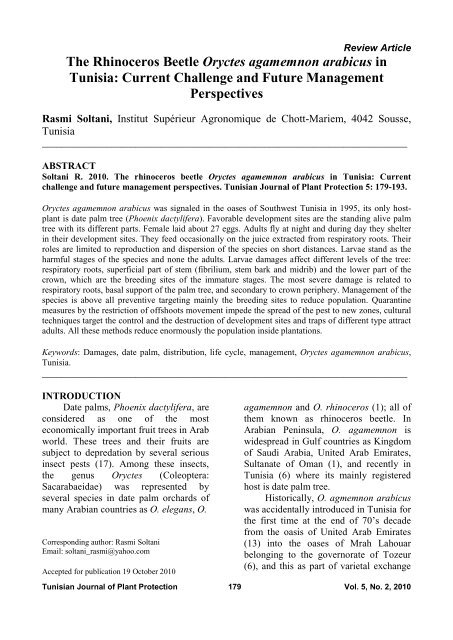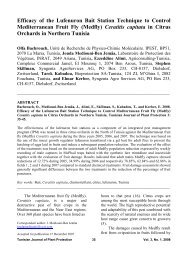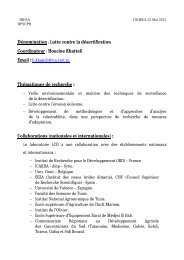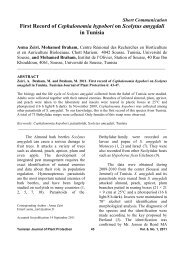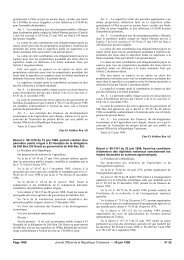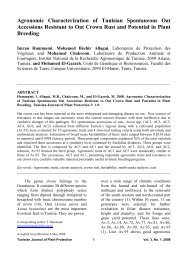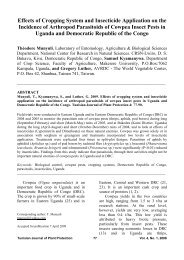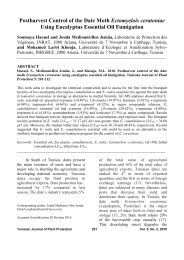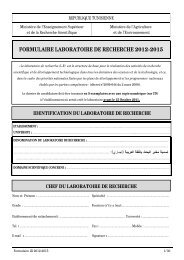The Rhinoceros Beetle Oryctes agamemnon arabicus in ... - Iresa
The Rhinoceros Beetle Oryctes agamemnon arabicus in ... - Iresa
The Rhinoceros Beetle Oryctes agamemnon arabicus in ... - Iresa
Create successful ePaper yourself
Turn your PDF publications into a flip-book with our unique Google optimized e-Paper software.
Review Article<strong>The</strong> <strong>Rh<strong>in</strong>oceros</strong> <strong>Beetle</strong> <strong>Oryctes</strong> <strong>agamemnon</strong> <strong>arabicus</strong> <strong>in</strong>Tunisia: Current Challenge and Future ManagementPerspectivesRasmi Soltani, Institut Supérieur Agronomique de Chott-Mariem, 4042 Sousse,Tunisia__________________________________________________________________________ABSTRACTSoltani R. 2010. <strong>The</strong> rh<strong>in</strong>oceros beetle <strong>Oryctes</strong> <strong>agamemnon</strong> <strong>arabicus</strong> <strong>in</strong> Tunisia: Currentchallenge and future management perspectives. Tunisian Journal of Plant Protection 5: 179-193.<strong>Oryctes</strong> <strong>agamemnon</strong> <strong>arabicus</strong> was signaled <strong>in</strong> the oases of Southwest Tunisia <strong>in</strong> 1995, its only hostplantis date palm tree (Phoenix dactylifera). Favorable development sites are the stand<strong>in</strong>g alive palmtree with its different parts. Female laid about 27 eggs. Adults fly at night and dur<strong>in</strong>g day they shelter<strong>in</strong> their development sites. <strong>The</strong>y feed occasionally on the juice extracted from respiratory roots. <strong>The</strong>irroles are limited to reproduction and dispersion of the species on short distances. Larvae stand as theharmful stages of the species and none the adults. Larvae damages affect different levels of the tree:respiratory roots, superficial part of stem (fibrilium, stem bark and midrib) and the lower part of thecrown, which are the breed<strong>in</strong>g sites of the immature stages. <strong>The</strong> most severe damage is related torespiratory roots, basal support of the palm tree, and secondary to crown periphery. Management of thespecies is above all preventive target<strong>in</strong>g ma<strong>in</strong>ly the breed<strong>in</strong>g sites to reduce population. Quarant<strong>in</strong>emeasures by the restriction of offshoots movement impede the spread of the pest to new zones, culturaltechniques target the control and the destruction of development sites and traps of different type attractadults. All these methods reduce enormously the population <strong>in</strong>side plantations.Keywords: Damages, date palm, distribution, life cycle, management, <strong>Oryctes</strong> <strong>agamemnon</strong> <strong>arabicus</strong>,Tunisia.__________________________________________________________________________INTRODUCTIONDate palms, Phoenix dactylifera, areconsidered as one of the mosteconomically important fruit trees <strong>in</strong> Arabworld. <strong>The</strong>se trees and their fruits aresubject to depredation by several serious<strong>in</strong>sect pests (17). Among these <strong>in</strong>sects,the genus <strong>Oryctes</strong> (Coleoptera:Sacarabaeidae) was represented byseveral species <strong>in</strong> date palm orchards ofmany Arabian countries as O. elegans, O.Correspond<strong>in</strong>g author: Rasmi SoltaniEmail: soltani_rasmi@yahoo.comAccepted for publication 19 October 2010<strong>agamemnon</strong> and O. rh<strong>in</strong>oceros (1); all ofthem known as rh<strong>in</strong>oceros beetle. InArabian Pen<strong>in</strong>sula, O. <strong>agamemnon</strong> iswidespread <strong>in</strong> Gulf countries as K<strong>in</strong>gdomof Saudi Arabia, United Arab Emirates,Sultanate of Oman (1), and recently <strong>in</strong>Tunisia (6) where its ma<strong>in</strong>ly registeredhost is date palm tree.Historically, O. agmemnon <strong>arabicus</strong>was accidentally <strong>in</strong>troduced <strong>in</strong> Tunisia forthe first time at the end of 70’s decadefrom the oasis of United Arab Emirates(13) <strong>in</strong>to the oases of Mrah Lahouarbelong<strong>in</strong>g to the governorate of Tozeur(6), and this as part of varietal exchangeTunisian Journal of Plant Protection 179 Vol. 5, No. 2, 2010
etween both countries. Closely l<strong>in</strong>ked topalm tree, it stands as the only registeredspecies of the genus <strong>Oryctes</strong> <strong>in</strong> someplantations of Southwest Tunisia (14).However, from its <strong>in</strong>troduction tothe first report of its severe damage,expressed by the sudden collapse of manyproductive palm trees <strong>in</strong> 1995, O.<strong>agamemnon</strong> <strong>arabicus</strong> populations haveconsiderably grown up and this specieshas become a major pest of date palm tree<strong>in</strong> this region. Few research studies arefocused <strong>in</strong> this species which threat<strong>in</strong>creases each year <strong>in</strong> <strong>in</strong>fested oases:despite this danger; no serious controlprograms were set up aga<strong>in</strong>st this beetle(14).<strong>The</strong> aim of this paper is to develop amanagement strategy based on fieldstudies conducted dur<strong>in</strong>g the last fifteenyears, to fight O. <strong>agamemnon</strong> <strong>arabicus</strong> <strong>in</strong>date palm plantations of SouthwestTunisia.INSECT DESCRIPTIONAdult of O. <strong>agamemnon</strong> <strong>arabicus</strong> arestocky, stout, black or reddish black <strong>in</strong>color with sh<strong>in</strong><strong>in</strong>g aspect. <strong>The</strong>y measure30-57 mm <strong>in</strong> length and 14-21 mm <strong>in</strong>breadth. <strong>The</strong> male is characterized by acurved cephalic horn and a largedepression on the pronotum (Fig. 1), bothcharacters are rudimentary and sometimesabsent on female. <strong>The</strong> pygidium isclothed by reddish brown hairs which aremore densely <strong>in</strong> female than male (13).Fig. 1. Holometabolous life cycle of <strong>Oryctes</strong> <strong>agamemnon</strong> <strong>arabicus</strong> and anexample of damage on the respiratory root parts of date palm tree (13).After eggs hatch<strong>in</strong>g, life cyclecompleted through three dist<strong>in</strong>guishlarval stages and a pupal period. At fulldevelopment, length of larva of thirdstage, which is the most destructive <strong>in</strong> thefield, can exceed 90 mm (13).Current distributionDelimit<strong>in</strong>g surveys performed <strong>in</strong>2006 <strong>in</strong>dicated that the <strong>in</strong>festation wasrestricted to some oases of extremeTunisian Journal of Plant Protection 180 Vol. 5, No. 2, 2010
Southwest, from Tozeur and Kebiligovernorates (Fig. 2), and permitted alsoto mark out the historical spread of thespecies <strong>in</strong> this zone. Based on thecollected data, the historical spread of O.<strong>agamemnon</strong> <strong>arabicus</strong> was characterizedby two dist<strong>in</strong>guished periods (14).Fig. 2. Geographical localization of the date palm oases <strong>in</strong> Southwest Tunisia (Djerid and Nefzaoua) (satellite photo,Google Earth).Before 1987, the spread of thisspecies was limited to Mrah Lahouaroases (387 ha) situated 5 Km <strong>in</strong> the Westof Tozeur town just on the North edge ofChott El Djerid (F1 <strong>in</strong> Fig. 3). However,<strong>in</strong>itially <strong>in</strong>troduced <strong>in</strong> little numbers (15larvae of third stage maximum), adultbeetles of first generations secured bytheir reproductive activity, the growth ofthe population and then its cont<strong>in</strong>uity andperpetuation <strong>in</strong> this new environment. Inaddition, adults, the only mobile andobserved stage out of the palm tree,assure the local and progressive spread ofthe pest between adjacent or borderedoases. Infestation reached the oasis ofDhraa El Janoubi located at 100 m <strong>in</strong> theWest of Mrah Lahouar and which cover200 ha. So, prelim<strong>in</strong>ary and based on this<strong>in</strong>formation, it is important to mentionthat flight activity can be considered asthe most likely method of spread on shortdistance both with<strong>in</strong> and betweenadjacent date palm plantations (14).Tunisian Journal of Plant Protection 181 Vol. 5, No. 2, 2010
Fig. 3. Distribution of O. <strong>agamemnon</strong> <strong>arabicus</strong> <strong>in</strong> the oases of Djerid zone (Tozeur): F 1: Mrah Lahouarand Dhraa El Janoubi, F 2: Ibn Chabbat, F 3: Dhafria, F 4: El Oudia I et II (satellite photo, Google Earth).After 1987, the lack of necessaryprimary plant material to achieve theplantation of Ibn Chabbat oases (F 2 <strong>in</strong>Fig. 3), located 5 Km <strong>in</strong> the North ofMrah Lahouar and <strong>in</strong> South of Chott ElGharsa, leaded to use offshoots orig<strong>in</strong>atedfrom <strong>in</strong>fested oases of Mrah Lahouar.This action permitted the spread of O.<strong>agamemnon</strong> <strong>arabicus</strong> between distantoases both <strong>in</strong> <strong>in</strong>tra- and <strong>in</strong>ter- regionallevel. In early 90’s, the same caseoccurred <strong>in</strong> the five localities of RjimMaatoug zone (1434.5 ha) located <strong>in</strong> theextreme Southwest of Kebili governorateand approximately 8 Km on the Southedges of Chott El Djerid (F <strong>in</strong> Fig. 4), thelack of offshoots <strong>in</strong> Kebili oases imposedthe use of offshoots orig<strong>in</strong>ated from IbnChabbat oases (800 ha), both to cont<strong>in</strong>uethe plantation process and to replace thelacks which favored more pest spread.Dur<strong>in</strong>g the 90’s decade and from IbnChabbat oases, the major site of thespread, O. <strong>agamemnon</strong> <strong>arabicus</strong> reachedthe oases of El Oudia (40 ha) and ElDhafria (250 ha) both situated <strong>in</strong> theNorth of Tozeur governorate (F 3 and F 4 <strong>in</strong>Fig. 3). Thus, the most likely mode ofspread between regions and distantplantations is with offshoots removedfrom <strong>in</strong>fested plantations (14).Tunisian Journal of Plant Protection 182 Vol. 5, No. 2, 2010
Fig. 4. Distribution of O. <strong>agamemnon</strong> <strong>arabicus</strong> <strong>in</strong> the oases of Nefzaoua (Kebili): Rjim Maatoug zone (F)constitute the only <strong>in</strong>fested zone (satellite photo, Google Earth).Many biotic and abiotic factors havecontributed to the spread of O.<strong>agamemnon</strong> <strong>arabicus</strong>. In fact, dur<strong>in</strong>g the15 years elapsed between its <strong>in</strong>troductionand its first report, favorable conditionsexpressed by adequate regional climate,abundance of food resources, absence ofnatural organisms (predators, parasitoidsand micro-organisms) that regulate thepopulation and time (years) allow<strong>in</strong>g pestacclimatization to local conditions.<strong>The</strong>refore, the pest reproduces rapidlyand outbreaks of its populations occurred.<strong>The</strong> biotic potential of O. <strong>agamemnon</strong><strong>arabicus</strong> may be considered as one of themajor factors <strong>in</strong>volved <strong>in</strong> its populationexplosion (14).All these conditions were enforced by theignorance of the species usually confusedwith other white grubs and thiscontributed ma<strong>in</strong>ly to its establishmentand spread. As a result, it became a realthreat to date palm trees. Actually,surveys estimated that the beetles affectedabout 3113.5 ha (Table 1) i.e., almost10%, of the total area of palm trees <strong>in</strong>Tunisia (14).Table 1. Distribution of O. <strong>agamemnon</strong> <strong>arabicus</strong> <strong>in</strong> the oases of Southwest TunisiaGovernorate of Tozeur Governorate of Kebili (Rjim Maatoug zone)Locality Area (ha) Locality Area (ha)Mrah Lahouar 389 Rjim Maatoug 1 300Edhraa El Janoubi 200 Ferdaous 1 360Ibn Chabbat 800 Ferdaous 2 349Ed Hafria 250 Nasr 1 281.5El Oudia 40 Nasr 2 144 TotalTotal 1679 - 1434.53113.5haTunisian Journal of Plant Protection 183 Vol. 5, No. 2, 2010
DEVELOPMENT SITES<strong>The</strong> availability of development orbreed<strong>in</strong>g sites and the knowledge of theirnature and quality are determ<strong>in</strong>ant <strong>in</strong> theexistence of any <strong>in</strong>sect population <strong>in</strong> agiven area. Indifferently of the <strong>in</strong>festedoasis <strong>in</strong> Southwest Tunisia, it has beenfound that the breed<strong>in</strong>g sites of O.<strong>agamemnon</strong> <strong>arabicus</strong> are the same both <strong>in</strong>the Djerid and Rjim Maatoug zones. Allthe stages develop <strong>in</strong> live stand<strong>in</strong>g palmtrees. <strong>The</strong> large number of beetles, eggsand larvae were collected from respiratoryroots both on the ground and <strong>in</strong> the aerialpart, on the external dead wood throughthe stem as the matrixes of fibrilium, thebark of stem and basal part of dry petioles(13, 14, 15).In Oman, O. <strong>agamemnon</strong> <strong>arabicus</strong> isconsidered as a fruit stalk borer whichlarvae are usually found <strong>in</strong>side the deadand weaken offshoots. In Saudi Arabia,larvae of O. elegans were found betweenthe frond bases and trunks (1). However,the most favored breed<strong>in</strong>g sites for O.rh<strong>in</strong>oceros <strong>in</strong> Pacific area are deadstand<strong>in</strong>g palms which die from old age,dead coconut trunks and stumps, anddecay<strong>in</strong>g cocoa pod humus (2, 16).As with all beetles, larvae of O.<strong>agamemnon</strong> <strong>arabicus</strong> hatch from eggs anddevelop <strong>in</strong>to nymphae, and theseultimately develop <strong>in</strong>to adult beetles. Eggsare deposited directly on the area of futuretarget. However, female burrows to lay theeggs s<strong>in</strong>gly 5 to 10 cm below the surfacebetween fibrous of respiratory roots,through the stem eggs are laid betweentough layers. In both cases and <strong>in</strong> newtargeted place, female chewed and reducethe fibrous roots or the matrixes offibrilium on small granules used to preparechipboard of firm material where eggs arelaid. However, when firm material exists,eggs are laid at <strong>in</strong>tervals along the tunnelmade <strong>in</strong> it. Each female lays at mean 27eggs <strong>in</strong> s<strong>in</strong>gle or several clutches (14).Favored breed<strong>in</strong>g sites are stand<strong>in</strong>galive date palm trees <strong>in</strong> the goodenterta<strong>in</strong>ed oases, weakened palms areless attacked than vigorous ones. In thezone of Tozeur, where the species firstlyappeared, targeted parts of stand<strong>in</strong>gvigorous palm trees are preferred tounhealthy and dead stand<strong>in</strong>g ones (13).DAMAGES, THREAT ANDECONOMIC IMPORTANCEIn Southwest Tunisia, O.<strong>agamemnon</strong> <strong>arabicus</strong> was localized<strong>in</strong>side plantations of less than 30 yearsold and damage caused by this pest, areirreversible, particularly <strong>in</strong> respiratoryroots part, and may result <strong>in</strong> one of thefollow<strong>in</strong>g symptoms, perceived throughsight, depend<strong>in</strong>g upon the stage of<strong>in</strong>festation (14):i) Occurrence of chewed planttissues on the ground beside the attackedside and on the upper surface of toughlayers,ii) Weakened bases of fibriliummatrixes and dry petioles made them easyto pull up,iii) Heavily attacks on offshootsl<strong>in</strong>ked to mother plant let them partiallydry with wr<strong>in</strong>kled aspects of palms.Damages are localized from thebottom to the top of the plant on therespiratory roots, external components ofthe stem and the basal levels of old greenpalms. Larvae of O. <strong>agamemnon</strong> <strong>arabicus</strong>constitute the ma<strong>in</strong>ly harmful stages (14)and not the adult beetle like for O.rh<strong>in</strong>oceros (2, 3, 12, 16) and O. elegans (1,11). <strong>The</strong> concealed nature of the pestmakes detection of <strong>in</strong>fested palms adifficult task.In respiratory roots, larvae move bycutt<strong>in</strong>g <strong>in</strong>to fibrous roots. Through thestem, matrixes of fibrilium, frond midribsand stem bark are the <strong>in</strong>terested part ofattack and larvae are never seen <strong>in</strong>side thestem. Basal part of crown, represented byTunisian Journal of Plant Protection 184 Vol. 5, No. 2, 2010
the fourth oldest floor of green palms,was also <strong>in</strong>fested by this pest but, greenpalms are not attacked and concernedparts are ma<strong>in</strong>ly matrixes of fibrilium andstem barks. Larvae move by feed<strong>in</strong>g onthe attacked tissues where they cut anddig tunnels. It is important to mention that<strong>in</strong>differently from the level of attackseach larva dig its own tunnel (14).<strong>The</strong> most important danger ofdamage appears on the attack ofrespiratory roots which represent thebasal support of the palm. In this part and<strong>in</strong> late stage of <strong>in</strong>festation, after severalsubsequent years of attacks, larvalgalleries can overlap and <strong>in</strong>terpenetrate.This leads to most severe damages: theformation of a hole of importantdimensions <strong>in</strong> roots. Thus, the plant basebecomes unbalanced by the weaken<strong>in</strong>g ofits support, and, consequently, the risk ofits sudden collapse <strong>in</strong>creases even undermoderate w<strong>in</strong>d. Happily, palms cansupport pest attacks for several years yetfor more than two decades depend<strong>in</strong>g onthe two next l<strong>in</strong>ked parameters: therepetitive attacks and the yearly registeredpopulation of larvae. This slow damageexpression constitutes a positive po<strong>in</strong>t <strong>in</strong>favor of palms which can be exploited tosave/cure <strong>in</strong>fested trees us<strong>in</strong>g severalcontrol methods if <strong>in</strong>festation wasdetected at early stage (14).Attacks were also registeredlaterally between fibrous roots at 40 cmfrom the stem. However, risks from thespecies were <strong>in</strong>creased when offshootstufts developed at the base of the tree; thisplace constitutes the most preferential siteto females’ beetle for eggs deposition (13,14, 15).Stem is covered for several yearswith the bases of the old dry fronds(matrixes of fibrilium and midrib),mak<strong>in</strong>g it rough, but with age these basesweather and the trunk becomes smootherwith visible scars of the bases (17).Attacks through different parts of stemare not harmful to palm trees becauselarvae bore <strong>in</strong>to dead parts withoutaffect<strong>in</strong>g the tree vital function. Eggs arelaid between reduced parts of thematrixes of fibrilium located between the<strong>in</strong>terior face of midrib and stem bark.<strong>The</strong>ir number can not exceed five <strong>in</strong>maximum. After eggs hatch<strong>in</strong>g, larvaebegan their attack as follows: theydestruct the tissues of fibrilium matrixes;after they attack superficially the stembark and can penetrate <strong>in</strong>side midrib only<strong>in</strong> third larval <strong>in</strong>stars where they cont<strong>in</strong>uetheir development until pupation. A frondmidrib assures the development of onlyone larva of third stage (14, 15).Crown attack <strong>in</strong>terests the basalfourth oldest floor of green palms. Newemerged adults, pupae and particularlylarvae of third stage are collected fromthis part and never eggs and larvae of firstand second stages. Invaded parts arema<strong>in</strong>ly the matrixes of fibrilium and thebark of stem. Green palms petioles aresuperficially <strong>in</strong>jured by mouthparts oflarvae but never <strong>in</strong>teriorly attackedbecause of the hardness of the woodwhich still alive and overloaded water(15, 14). However, existence of larvae oncrown periphery level can be at the orig<strong>in</strong>of <strong>in</strong>direct damage represented byharmful fungal diseases that are alwaysrelated to stem <strong>in</strong>vasion (6, 13, 14).<strong>The</strong> pest does not affect the yearlyharvest of date because attacks werenever registered on the base of fruitbunches (14). Thus, this species wasconsidered as secondary pest result<strong>in</strong>g <strong>in</strong>its late identification and lack<strong>in</strong>g <strong>in</strong>related research studies.Offshoots developed <strong>in</strong> tuftslaterally on respiratory roots and allaround the date palm tree (17). <strong>The</strong>seunclean places are the best suited sites foradult beetles for egg deposition. Itcontributes to enhance the risks related toTunisian Journal of Plant Protection 185 Vol. 5, No. 2, 2010
strict pre-departure period (3 months) andpost-entry period (9 months) as aquarant<strong>in</strong>e protocol. In fact, dur<strong>in</strong>g thefirst period selected and pulled offshoots,orig<strong>in</strong>at<strong>in</strong>g from <strong>in</strong>fested areas, must beset <strong>in</strong> nursery where they undergo asevere control by the cont<strong>in</strong>uous surveyof the presence of any form of the pest(eggs, larva, pupa or adult) <strong>in</strong> conjunctionwith <strong>in</strong>secticides spray<strong>in</strong>g untilplantation. This method might be held asan efficient way to prevent the spread of<strong>Oryctes</strong> through plant<strong>in</strong>g material andmust be considered as an importantcomponent of the <strong>Oryctes</strong>-managementprogram that offers the much neededquarant<strong>in</strong>e security aga<strong>in</strong>st these pests.However, the second period <strong>in</strong>terestedautonomous offshoots dur<strong>in</strong>g the firstyear after plantation. A simple methodcan be mentioned and which would avoidand restrict the spread of adults and theidentification of suspicious materialundetected by quarant<strong>in</strong>e service. Itstands <strong>in</strong> cag<strong>in</strong>g offshoots with a meshnet with<strong>in</strong> plantations. This method couldserve as a useful post-entry or postplantationprotocol. This, if done undersupervision and proper certification,would play a major role <strong>in</strong> prevent<strong>in</strong>gspread of the pest to new plantations,regions and countries.AGRONOMIC MEASURESAgronomic methods which may beapplied aga<strong>in</strong>st O. <strong>agamemnon</strong> <strong>arabicus</strong><strong>in</strong> the oasis of Southwest Tunisia are easyand not expensive but meticulous.Universally, major recommendationshave been made for cautiousphytosanitary steps <strong>in</strong>side and aroundplantations to destroy any life historystages found <strong>in</strong> all breed<strong>in</strong>g sites. Forfarmers, sanitation constitutes the mostsimple and effective way of controll<strong>in</strong>gthe species. Its pr<strong>in</strong>ciple, based on severalmethods and techniques, is to unbalancethe middle of life of the pest byma<strong>in</strong>ta<strong>in</strong><strong>in</strong>g the grow<strong>in</strong>g area <strong>in</strong> a cleancondition. It ma<strong>in</strong>ly targeted breed<strong>in</strong>gsites (13).In the first part, the control targetsoviposition and breed<strong>in</strong>g sites at differentlevels of palm trees. It is important tomention that this control method has to beapplied out of the season of reproduction,between November and late April. Majoroperations are (14):• Eradication of suitable ovipositionand breed<strong>in</strong>g sites of the pest by theelim<strong>in</strong>ation of destroyed vegetal materialpreviously transformed by larvae to smallgranules (firm material) where femaleslaid their eggs and young larvae live anddevelop until new adult emergence.Moreover, this operation allows on onehand to expose these parts to ambient airand sun radiations mak<strong>in</strong>g them dry, hardand unattractive to beetle, and on theother hand the handpick<strong>in</strong>g (manualextraction) us<strong>in</strong>g a metallic wire of allencountered life history stages of the pestfrom feed<strong>in</strong>g tunnels and theirdestruction.• Throughout stem, farmers have touse a saw to prune on scale the drypetioles levels. This action destructs theoviposition sites of beetles by elim<strong>in</strong>at<strong>in</strong>gthe matrixes of fibrilium with larvae andadults. However, it is far better to keepthe last 4 to 6 levels of dry petioleslocated just under the crown as a trap tobeetles <strong>in</strong> the goal to avoid the passage of<strong>in</strong>vasion to the basal levels of the crown.<strong>The</strong> second part is related to uncleanpalm trees which display too manyoffshoots at their base. <strong>The</strong>se palms offerto beetles suitable sites for reproductionand eggs oviposition. <strong>The</strong>refore, to breakthe pest cycle <strong>in</strong> this place, it is necessaryto make it clean, exposed to sun light andair. Accord<strong>in</strong>gly, farmers are encouragedto elim<strong>in</strong>ate the excessive number ofoffshoots which can be either used toTunisian Journal of Plant Protection 187 Vol. 5, No. 2, 2010
eplace lacks <strong>in</strong>side the same plantationafter be<strong>in</strong>g treated with <strong>in</strong>secticides to killlarvae, develop<strong>in</strong>g <strong>in</strong> its basal part, ormust be automatically eradicated.However, sanitation is a carefulwork and a slow methodical processwhich can be h<strong>in</strong>dered by the ability todetect <strong>in</strong>fested material and the necessarytime to execute this work. Approximatelyevery five years, the M<strong>in</strong>istry ofAgriculture launches a campaign oferadication of this pest by collect<strong>in</strong>g andburn<strong>in</strong>g the various stages of the pest <strong>in</strong><strong>in</strong>fested oases. Despite the grant<strong>in</strong>g off<strong>in</strong>ancial <strong>in</strong>centives to make this work,the low <strong>in</strong>volvement of the farmers <strong>in</strong> thecampaign follow up has translated <strong>in</strong>to asignificant growth of the O. <strong>agamemnon</strong><strong>arabicus</strong> population. Consequently, thelack of consciousness ris<strong>in</strong>g about therisks of this pest <strong>in</strong>duce few farmers toapply these techniques with<strong>in</strong> theirplantations (14).TRAINING AND EXTENSIONExtension constitutes a veryimportant method to diffuse <strong>in</strong>formationbetween farmers. In Southwest Tunisia,few meet<strong>in</strong>g and studies are organized onthe subject of this pest. Thus, the solutionconsists <strong>in</strong> the organization of meet<strong>in</strong>gconferences, field days, and workshops <strong>in</strong>collaboration between research<strong>in</strong>stitutions (researchers), agriculturalorganisms (eng<strong>in</strong>eers, technicians) andfarmers are <strong>in</strong>dispensable to the diffusionof important <strong>in</strong>formation about therelative pest danger. In addition, the pestis free of control by natural enemies ondate palm oases of Tunisia which makeworse this problem. Consequently, thegoals of these meet<strong>in</strong>gs and tra<strong>in</strong><strong>in</strong>g are totake farmers <strong>in</strong>formed concern<strong>in</strong>g meanof control of this pest. Farmers can alsohelp to the diffusion of these techniquesto other farmers.CHEMICAL CONTROLPresently, chemical controlperfected aga<strong>in</strong>st O. <strong>agamemnon</strong> <strong>arabicus</strong>is quiet <strong>in</strong>effective. Subsequently, thispest management of both <strong>in</strong> oldproductive and young date palm oasesscarcely relies on <strong>in</strong>secticide use that isalmost absent. This is due <strong>in</strong> part tospecific factors <strong>in</strong> relation with thebiology and ecology of the species, and <strong>in</strong>other part to the morphology of the plant(problems of access to the crown ofmature palms). However, <strong>in</strong>secticides canbe used for both as preventive andcurative applications as listed below(unpublished data).Preventive treatment. Preventivetreatments have to be applied dur<strong>in</strong>g thewhole period of adults’ activities to besure about their effectiveness <strong>in</strong> kill<strong>in</strong>gadults mak<strong>in</strong>g possible the prevention oftheir entry <strong>in</strong> the reproduction andoviposition sites situated on differentlevels of the palm tree. Next applicationscan be useful: Stem and crownspray<strong>in</strong>g/soak<strong>in</strong>g. Protect<strong>in</strong>g wounds and entryholes localized on the aerial part of therespiratory roots with <strong>in</strong>secticides. Use of repellent products onthe crown of productive palms and <strong>in</strong> newplantations to drive away adults from thepalm tree.Curative treatment. Curativespray<strong>in</strong>g <strong>in</strong>tended for the immature stageslocated on the respiratory roots are<strong>in</strong>effective, the pesticide emulsion can notreach the location of these stages wellprotected <strong>in</strong>side their shelter. However, ifthe spray<strong>in</strong>g focus on the higher parts ofmature palm trees, <strong>in</strong> this case and to beeffective, specific treatment must beapplied by spray<strong>in</strong>g or soak<strong>in</strong>g the wholestem and crown. <strong>The</strong> application of suchTunisian Journal of Plant Protection 188 Vol. 5, No. 2, 2010
type of treatment, which requires higherdosages of chemical products, constitutesthe only way to make possible the contactof pesticide with different developmentalstages and then its effectiveness.However, although the efficiencyapplication of this method, it isconsidered to be too expensive forgeneral use with<strong>in</strong> plantations comparedto the low value per hectare of dateproduction which severely limitsexpenditure on control measures.Moreover, other serious hazards <strong>in</strong>volved<strong>in</strong> spray<strong>in</strong>g tall palms by this way, due tothe loss of products at the time of itsapplication to higher palms make farmershighly exposed to the risks of toxicantspillage and <strong>in</strong>halation. Thus,disadvantages of this application resideon the use of important quantities ofchemicals per treatment endangered byrepetitive treatments to ensure theremanence of the product and itsefficiency and this was not safe both toenvironment and human.However, chemical control wasrecommended and constitutes the widelyadvocated method of control(unpublished work): To sweep out the exist<strong>in</strong>gstages of the pest with<strong>in</strong> offshoots, beforebe<strong>in</strong>g replanted offshoots bases aredipped with<strong>in</strong> a barrel conta<strong>in</strong><strong>in</strong>g asolution of <strong>in</strong>secticide for 5 m<strong>in</strong>,necessary time to penetration of thepesticide <strong>in</strong>side larval galleries. By thisway, larvae were killed by the product <strong>in</strong>a short period. This method can ensurethe safety of offshoots dur<strong>in</strong>g the residualperiod, after that they constitute a newtarget to other <strong>in</strong>vasion by adult beetles. To protect young palmreplant<strong>in</strong>g (< 5 years old), by soak<strong>in</strong>g allthe plant with pesticide dur<strong>in</strong>g the periodof adults’ activity. Use of repellent products asnaphthalene balls <strong>in</strong>to the frond axils canbe very effective <strong>in</strong> protect<strong>in</strong>g youngpalms (17) and also <strong>in</strong> old palms bydriv<strong>in</strong>g away adults before they causedamage.ATTRACTANTSCompost heaps. Traps of varioustypes can be used. <strong>The</strong> simplest are on theform of breed<strong>in</strong>g sites and play the role ofa trap or attractant for adults such ascompost of sheep manure and sawdust orheaps of decay<strong>in</strong>g vegetable matter buried<strong>in</strong>side a pit on the ground with<strong>in</strong> <strong>in</strong>vadedplantations. Traps of compost must be put<strong>in</strong> place on the late spr<strong>in</strong>g early summer(late April to May) before the start<strong>in</strong>g ofthe reproduction and oviposition periods(14).<strong>The</strong>se organic heaps operate as trapsby attract<strong>in</strong>g a large number of beetles, <strong>in</strong>particularly females, which lay downtheir eggs and subsequently largelycontribute <strong>in</strong> the decl<strong>in</strong>e of the pest’spopulations <strong>in</strong>side plantations and of theirimpact on the palm trees (14).Consequently, compost heaps standsas very favorable breed<strong>in</strong>g sites for the<strong>Oryctes</strong> species and then can receive andproduce large populations <strong>in</strong> one cycle. Inthis case, compost piles with<strong>in</strong> plantationsshould be ma<strong>in</strong>ta<strong>in</strong>ed properly. Its upkeep<strong>in</strong>cludes the destruction of all life stagesof the pest and its treatment us<strong>in</strong>g<strong>in</strong>secticide or <strong>in</strong>oculums of the parasiticfungus like Metarhizium anisopliaewhich contam<strong>in</strong>ated and killed thebeetles’ larvae of the similar species O.rh<strong>in</strong>oceros <strong>in</strong> the Pacific region (8, 9, 10).Also, before its application as soilfertilizer, compost must be sieved toelim<strong>in</strong>ate the rema<strong>in</strong>der of larvae andadults (14).Light traps. Adults are nocturnaland attracted to any source of light. Earlyexperiences at trapp<strong>in</strong>g <strong>Oryctes</strong> <strong>in</strong> Mrahlahouar zone <strong>in</strong>clude the use of one lightTunisian Journal of Plant Protection 189 Vol. 5, No. 2, 2010
trap by the Regional Research Center ofOasis Agriculture at Deguech (6). <strong>The</strong> useof only one light trap <strong>in</strong> the pilot station(3.5 ha) of Rjim Maatoug permitted toexperiment the effectiveness of light trapfor three years. However, more than 550adults are trapped per season of activity,from June to mid-October. <strong>The</strong>se goodresults and by the availability of severaltraps <strong>in</strong>side oasis and their exploitationfor successive years dur<strong>in</strong>g the period ofactivity of beetles can ensure importantreduction of the pest population (14).BIOLOGICAL CONTROLO. <strong>agamemnon</strong> <strong>arabicus</strong> is an exoticspecies <strong>in</strong> Tunisia. <strong>The</strong>refore, naturalfactors that keep the beetle under control<strong>in</strong> its native range are not present when<strong>in</strong>troduced and this factor facilitates andmakes easy its reproduction and localspread. Biological control via parasitoids,predators and entomo-pathogenic fungiare not yet identified and availableaga<strong>in</strong>st this pest <strong>in</strong> Tunisia due to itsrecent <strong>in</strong>troduction and to the lack ofdeeper relative studies (14).RECOMMENDATIONSFor rais<strong>in</strong>g awareness and capacitybuild<strong>in</strong>g, it is necessary to make farmersof the Southwest region understand<strong>in</strong>gthat O. <strong>agamemnon</strong> <strong>arabicus</strong> is not somuch a national responsibility, but rathera regional responsibility. If it was alreadyestablished <strong>in</strong> some oases of the region, itis highly likely that it will eventuallyspread to others (14). Next steps areneeded both to limit its spread and itspopulation <strong>in</strong>crease with<strong>in</strong> <strong>in</strong>fested oases:■ Adoption and serious applicationof strict quarant<strong>in</strong>e measures on themovement of offshoots from <strong>in</strong>fested tohealthy areas,■ Need of more attention to the pestfrom the authority and scientists due to itsthreat to palm trees,■ Distribution of the pest should beassessed by exploratory surveys <strong>in</strong>healthy regions,■ Adoption and application ofphytosanitary steps <strong>in</strong> <strong>in</strong>fested oases,■ Need to organize programs on O.<strong>agamemnon</strong> <strong>arabicus</strong> to get farmers<strong>in</strong>formed about the real danger of thespecies and its threat on this economicallyimportant crop,■ Mak<strong>in</strong>g available <strong>in</strong>formation onthis pest <strong>in</strong> the regions concerned withdate palm trees cultivation and <strong>in</strong>clud<strong>in</strong>ggood photos of larvae, adults, symptomsand damages,■ Extension of <strong>in</strong>formation oncontrol measures to concerned farmers,■ Extension of compost use with<strong>in</strong>plantation to a significantly decrease bothof the pest’s impact on palm trees and oftheir populations.■ Support and implementation ofIPM program■ Development of mass trapp<strong>in</strong>gus<strong>in</strong>g light traps and compost technique■ Establishment of researchprograms to tackle and develop masstrapp<strong>in</strong>g with aggregation pheromone■ Introduction of biological controlrely<strong>in</strong>g on the use of the fungusMetharizium anisopliae and theantagonist <strong>Oryctes</strong> virus show<strong>in</strong>geffective results <strong>in</strong> the Pacific coconuts’plantation (4, 5, 11).CONCLUSIONIn conclusion, O. <strong>agamemnon</strong><strong>arabicus</strong> has became a major pest and aworry<strong>in</strong>g threat to palm trees <strong>in</strong> <strong>in</strong>festedoases of Southwest Tunisia where it hasthriven unnoticed. Economically, it isconsidered as secondary pest withouteffect on production. This po<strong>in</strong>t madefarmers and adm<strong>in</strong>istration <strong>in</strong> charges ofagriculture unaware of the hazard for tworeasons: the unperceived damage and theTunisian Journal of Plant Protection 190 Vol. 5, No. 2, 2010
small number of yearly collapsed palmtrees.All means of its management stillrudimentary and traditional rely<strong>in</strong>gma<strong>in</strong>ly on hand collection of differentstages. <strong>The</strong>n, farmers are encouraged toachieve a careful and <strong>in</strong>tensive workevery year to cleanse their plantations but,this repeated work is very hard and timeconsum<strong>in</strong>g and farmers are unable tocontrol all their palm trees. Consequently,they give up collect<strong>in</strong>g the pest whichpopulation explode and becameuncontrollable.Fac<strong>in</strong>g to this situation and due tothe <strong>in</strong>effectiveness of chemical controland the lack of biological control, severequarant<strong>in</strong>e measures are the only way toprevent the spread of the pest out ofunhealthy zones. Obviously, it is time toconsider this species as a serious pest ofpalm trees <strong>in</strong> Tunisia. So, first steps haveto target the control and to limit itspopulations; this can be possible by: i)<strong>in</strong>form<strong>in</strong>g farmers how to use thecompost technique to bait adults, ii)study<strong>in</strong>g the possibility of biologicalcontrol by the <strong>in</strong>troduction of naturalenemies <strong>in</strong>side <strong>in</strong>fested oases.ACKNOWLEDGEMENTSOur thanks go specifically to Dr. IkbelChaieb, from the Institut National de RechercheAgronomique de Tunisie (INRAT) for his help <strong>in</strong> therevision and amelioration of the manuscript content.__________________________________________________________________________RESUMESoltani R. 2010. Le scarabée rh<strong>in</strong>océros <strong>Oryctes</strong> <strong>agamemnon</strong> <strong>arabicus</strong> en Tunisie: situationactuelle et les futures perspectives de lutte. Tunisian Journal of Plant Protection 5: 179-193.<strong>Oryctes</strong> <strong>agamemnon</strong> <strong>arabicus</strong> a été signalé dans certa<strong>in</strong>s oasis du sud ouest Tunisien en 1995. Les sitesfavorables à son développement sont les différentes parties du palmier dattier vivant. La femelle déposeenviron 27 œufs. Les adultes sont nocturnes et passent le jour cachés dans leur abri, ils s’alimententoccasionnellement sur le jus extrait à partir des rac<strong>in</strong>es respiratoires. Leur rôle est limité à lareproduction et à la dispersion de l’espèce sur de courtes distances. Cependant, les larves représententles stades nuisibles de l’espèce et non les adultes. Elles s’attaquent à différentes parties du palmierdattier, rac<strong>in</strong>es respiratoires, parties superficielles du stipe (fibrilium, écorce du stipe et pétiole sec) etla base de la couronne. Ces derniers représentent les sites de développement d’<strong>Oryctes</strong>. Le danger réelde cette espèce réside dans l’attaque de la zone respiratoire de la rac<strong>in</strong>e, support de base de la plante etsecondairement à la périphérie de la couronne. La lutte contre cette espèce est avant tout préventiveciblant les sites d’élevage af<strong>in</strong> de réduire les populations. Les mesures de quaranta<strong>in</strong>e par l’<strong>in</strong>terdictiondes mouvements des rejets bloquent la dispersion de l’espèce vers de nouvelles zones, les techniquesculturales ciblent le contrôle et la destruction des sites de développement et les pièges de différentstypes attirent les adultes. Toutes ces méthodes contribuent à réduire considérablement les populations àl’<strong>in</strong>térieur des plantations.Mots clés: Cycle de vie, dégâts, lutte, <strong>Oryctes</strong> <strong>agamemnon</strong> <strong>arabicus</strong>, palmier dattier, Tunisie.___________________________________________________________________________<strong>Oryctes</strong> <strong>agamemnon</strong> <strong>arabicus</strong>.2010Tunisian Journal of Plant Protection 5: 179-193ملخصسلطاني، رسمي.المستقبلية لإدارتها.الخنفساء وحيدة القرنفي تونس: الوضع الراهن والآفاقفي واحات الجنوب الغربيتمت الإشارة إلى وجود حشرة الخنفساء وحيدة القرنالتونسي في نخيل التمر المضيف الوحيد للحشرة. وتتمرآز مواقع نمو آل أطوار هذه الآفة على مختلف(<strong>Oryctes</strong> <strong>agamemnon</strong> <strong>arabicus</strong>)1995، يعدّTunisian Journal of Plant Protection 191 Vol. 5, No. 2, 2010
أجزاء النخيل الحي، حيث تضع الأنثى ما يقارب بيضة. تع ّد هذه الآفة من الحشرات الليلية حيث تختبئ أثناء النهار فيمواقع تطورها على النخلة وتنشط خلال الليل. وهي تتغذى عَرَضيًا على العصارة المستخرجة من الجذور التنفسية للنخلة .ويقتصر دور البالغات على التزاوج والمساهمة في انتشار النوع لمسافات قصيرة. ولا يمكن اعتبار الحشرة الكاملة ضارةبالنخلة مقارنة بالأطوار اليرقية التي تلحق أضرارا بأجزاء مختلفة من النخلة: منطقة الجذور التنفسية والأجزاء الخارجيةللساق والمنطقة السفلية من الجريد الأخضر حيث تمثل هذه الأهداف أهم مواقع نمو مختلف أطوار الحشرة. وتع ّد الأضرارالمحدثة في منطقة الجذور، التي تمثل قاعدة ارتكاز النخلة، الأخطر على الإطلاق بينما تعتبر الأضرار الموجودة علىمحيط التاج ثانوية ودون خطر يذآر. أما فيما يخص طرق مكافحة هذه الحشرة فتعد وقائية قبل آل شيء وتستهدف أساسامواقع تزاوج الحشرة للحد من آثافة أعدادها. أما تدابير الحجر الزراعي المتمثلة في تقييد تبادل الفسائل بين المناطقفتعتبر من أهم التدابير لمنع الحشرة إلى مناطق جديدة زيادة؛ بالإضافة إلى التقنيات الزراعية المتاحة التي تهدف أساساإلى تدمير مواقع تطور الحشرة للحد من أعدادها وآذلك استعمال المصائد بمختلف أنواعها لجذب بالغات الحشرة. تسهمآل هذه الطرائق مساهمة آبيرة في الحد من أعداد الحشرة داخل الواحات.نخيل التمر، <strong>Oryctes</strong> <strong>agamemnon</strong> <strong>arabicus</strong>__________________________________________________________________________27آلمات مفتاحية: انتشار، أضرار، تونس، دورة حياة، مكافحة،LITERATURE CITED1. Al-Sayed, A.E. and Al-Tamiemi, S.S. 1999.Seasonal activity of the fruit stalk-borer,<strong>Oryctes</strong> <strong>agamemnon</strong> (Burm.) (Coleoptera-Scarabaeidae) <strong>in</strong> Sultanate of Oman. Egypt. J.Agric. Res. 77: 1597-1605.2. Bedford, G.O. 1976. Observations on the biologyand ecology of <strong>Oryctes</strong> rh<strong>in</strong>oceros andScapanes australis (Coleoptera: Scarabaeidae:Dynast<strong>in</strong>ae): Pests. J. Aust. Entomol. Soc. 15:241-251.3. Hammes, C. and Monsarrat, P. 1974. Recherchessur <strong>Oryctes</strong> rh<strong>in</strong>oceros L. Source CahiersORSTOM. Série Biologie 22: 43-91.4. Huger, A.M. 1966. A virus disease of the Indianrh<strong>in</strong>oceros beetle, <strong>Oryctes</strong> rh<strong>in</strong>oceros(L<strong>in</strong>naeus), caused by a new type of <strong>in</strong>sectvirus, Rhabdionvirus oryctes. J. Invert. Pathol.(Special issue) 8: 38-52.5. Huger, A.M. 2005. <strong>The</strong> <strong>Oryctes</strong> virus: Itsdetection, identification, and implementation <strong>in</strong>biological control of the coconut palmrh<strong>in</strong>oceros beetle, <strong>Oryctes</strong> rh<strong>in</strong>oceros(Coleoptera: Scarabaeidae). J. Invert. Pathol.89: 78-84.6. Khoualdia, O. and Rhouma, A. 1997. Premièresobservations sur <strong>Oryctes</strong> <strong>agamemnon</strong>, ravageurdu palmier dattier en Tunisie. Fruits 52: 111-115.7. Lepesme, P. 1947. Les <strong>in</strong>sectes des palmiers. PaulLechevalier Editions, France, 799 pp.8. Ohler, J.G. 1999. Modern Coconut Management.Palm Cultivation and Products. FAO and<strong>in</strong>termediate technology publications Ltd,London, UK, 458 pp.9. Ramle, M., Mohd, B.W., Norman, K., Mukesh,S., and Siti Ramlah, A.A. 1999. Impact ofMetarhizium anisopliae (Deuteromycot<strong>in</strong>a:Hyphomycetes) applied by wet and dry<strong>in</strong>oculum on oil palm rh<strong>in</strong>oceros beetles,<strong>Oryctes</strong> rh<strong>in</strong>oceros (Coleoptera: Scarabaeidae).J. Oil Palm Res. 2: 25-40.10. Ramle, M., Wahid, M.B., Norman, K., Glare,T.R., and Jackson, T.A. 2005. <strong>The</strong> <strong>in</strong>cidenceand use of <strong>Oryctes</strong> virus for control ofrh<strong>in</strong>oceros beetle <strong>in</strong> oil palm plantations <strong>in</strong>Malaysia. J. Invert. Pathol. 89: 85-90.11. Rochat, D., Mohammadpoor, K., Maloose, C.,Avand-Faghih, A., Lettere, M., Beauhaire, J.,Mor<strong>in</strong>, J.P., Pezier, A., Renou, M., andAbdollahi, G.A. 2004. Male aggregationpheromone of date palm fruit stalks borer<strong>Oryctes</strong> elegans. J. Chem. Ecol. 30: 378-407.12. Sivapragasam, A. 1988. <strong>The</strong> <strong>Rh<strong>in</strong>oceros</strong> <strong>Beetle</strong>,<strong>Oryctes</strong> rh<strong>in</strong>oceros (L<strong>in</strong>n.): An appraisal of itsproblem and control <strong>in</strong> young Coconutreplant<strong>in</strong>gs <strong>in</strong> Malaysia. Workshop on coconutreplant<strong>in</strong>g, UNDP/FAO Projet RAS/80/032.November 23-27, 1988, Mardi, Malaysia.13. Soltani, R. 2004. <strong>Oryctes</strong> <strong>agamemnon</strong>Burmeister (Coleoptera, Scarabaeidae):contribution à l’étude de sa biologie et de sesdégâts dans les Oasis du Djérid au Sudtunisien. Diplôme d’Etudes Approfondies.Ecole Supérieure d’Horticulture et d’Elevagede Chott-Mariem, Tunisie, 81 pp.14. Soltani, R. 2009. <strong>Oryctes</strong> <strong>agamemnon</strong> <strong>arabicus</strong>Fairmaire, 1896: Etude bio-écologique etéthologique dans les oasis de Rjim Maâtoug auSud Ouest Tunisien. Thèse de Doctorat, InstitutSupérieur Agronomique de Chott-Mariem,Tunisie, 152 pp.15. Soltani, R.,Chaieb, I., and Ben Hamouda, M.H.2008. Descriptive study of damage caused bythe rh<strong>in</strong>oceros beetle, <strong>Oryctes</strong> <strong>agamemnon</strong>, andits <strong>in</strong>fluence on date palm oases of RjimMaatoug, Tunisia. J. Insect Sci. 8: 53. Availableonl<strong>in</strong>e: <strong>in</strong>sectscience.org/8.53.Tunisian Journal of Plant Protection 192 Vol. 5, No. 2, 2010
16. Waterhouse, D.F. and Norris, K.R. 1987.<strong>Oryctes</strong> rh<strong>in</strong>oceros (L<strong>in</strong>naeus). Pages 101-117.In: Biological control: Pacific prospects. D.F.Waterhouse, and K.R. Norris, ACIAR,Melbourne: Inkata Press.17. Zaid, A. and De Wet, P.F. 2002. Botanical andsystematic description of the date palm. In:Date palm cultivation. FAO Plant Productionand Protection Paper 156, Rev.1.-----------------Tunisian Journal of Plant Protection 193 Vol. 5, No. 2, 2010
Tunisian Journal of Plant Protection 194 Vol. 5, No. 2, 2010


